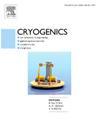Research on a solid Nitrogen-Cooled cryogenic system for MgB2 superconducting magnets used in gyrotrons
IF 1.8
3区 工程技术
Q3 PHYSICS, APPLIED
引用次数: 0
Abstract
A cryogenic cooling system for a superconducting magnet used in gyrotrons has been studied. The superconducting magnet was fabricated using MgB2 wire and was designed to achieve a maximum magnetic flux density of ∼1.3 T. Firstly, the electromagnetic design was carried out, based on which the mechanical design and manufacturing were completed. In preliminary tests, the MgB2 superconducting magnet was cooled by direct conduction cooling using four cryocoolers, and magnetization and demagnetization tests were performed at several different temperatures between 12 K and 20 K. Subsequently, the magnet was integrated into a carefully designed cryostat. Detailed heat transfer analyses and calculations were conducted during the design of the cryogenic system. The superconducting magnet is welded into a sealed reservoir and cooled through contact with nitrogen coolant (including both convection and conduction). The large heat capacity of solid nitrogen at low temperatures is utilized to maintain the temperature of the magnet over extended periods of time. The solid nitrogen reservoir is cooled by the second stage of a two-stage GM cryocooler and is enclosed within a cold shield cooled by the first stage. Specifically, to extend the holding time of solid nitrogen at low temperatures, a cryocooler chamber device is employed, which enables the detachment and repositioning of the cryocooler’s cold head while the magnet is in normal operation. Experimental results show that the cryogenic cooling system can cool the MgB2 superconducting magnet to nearly 4.5 K. With the cold head detached, the magnet operates stably at a working current of 84 A for over 4 h, during which the magnet’s temperature increased from approximately 5 K to around 14 K. The maximum magnetic field strength achieved is 1.295 ± 0.01 T, meeting the design requirements.
回旋管用MgB2超导磁体固体氮冷却低温系统的研究
研究了一种用于回旋管的超导磁体低温冷却系统。采用MgB2线制备超导磁体,设计最大磁通密度为~ 1.3 t。首先进行了电磁设计,在此基础上完成了机械设计和制造。在初步试验中,采用4台制冷机对MgB2超导磁体进行了直接传导冷却,并在12 ~ 20 K的不同温度下进行了充磁和退磁试验。随后,磁铁被集成到一个精心设计的低温恒温器中。在低温系统的设计过程中进行了详细的传热分析和计算。超导磁体焊接在密封的贮槽中,通过与氮气冷却剂接触(包括对流和传导)进行冷却。固体氮在低温下的大热容量被用来维持磁铁在较长时间内的温度。固体氮储存库由两级GM制冷机的第二级冷却,并封闭在由第一级冷却的冷罩内。具体来说,为了延长固体氮在低温下的保温时间,采用了冷冻室装置,可以在磁铁正常工作的情况下,将冷冻器的冷头分离并重新定位。实验结果表明,低温冷却系统可将MgB2超导磁体冷却至近4.5 K。当冷头分离后,磁体在84 a的工作电流下稳定工作超过4小时,在此期间磁体的温度从大约5 K上升到大约14 K。实现的最大磁场强度为1.295±0.01 T,满足设计要求。
本文章由计算机程序翻译,如有差异,请以英文原文为准。
求助全文
约1分钟内获得全文
求助全文
来源期刊

Cryogenics
物理-热力学
CiteScore
3.80
自引率
9.50%
发文量
0
审稿时长
2.1 months
期刊介绍:
Cryogenics is the world''s leading journal focusing on all aspects of cryoengineering and cryogenics. Papers published in Cryogenics cover a wide variety of subjects in low temperature engineering and research. Among the areas covered are:
- Applications of superconductivity: magnets, electronics, devices
- Superconductors and their properties
- Properties of materials: metals, alloys, composites, polymers, insulations
- New applications of cryogenic technology to processes, devices, machinery
- Refrigeration and liquefaction technology
- Thermodynamics
- Fluid properties and fluid mechanics
- Heat transfer
- Thermometry and measurement science
- Cryogenics in medicine
- Cryoelectronics
 求助内容:
求助内容: 应助结果提醒方式:
应助结果提醒方式:


